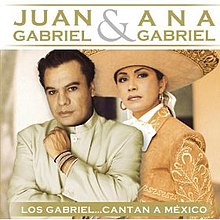
Mi México is the seventh studio album by Mexican pop singer Ana Gabriel. It was released on 1991. This time she came back with a different style, she changed the pop genre for ranchera and regional. It has sold 4.5 million worldwide.

Silueta is the 8th studio album by Mexican pop singer Ana Gabriel. It was released in 1992. This material was produced by herself and Max Pierre.
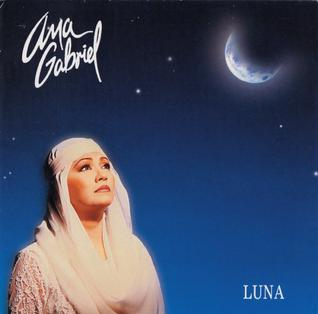
Luna is the 9th studio album by Mexican pop singer Ana Gabriel. It was released on November 9, 1993. This material was produced by herself.

Ayer y Hoy is the 10th studio album by Mexican pop singer Ana Gabriel. It was released on 1994. This material was produced by herself. She praises several idols of ranchera music with this material like Agustín Lara, José A. Jiménez, Juan Gabriel, Armando Manzanero and Cuco Sánchez. Ayer y Hoy was nominated for a Lo Nuestro Award for Regional Mexican Album of the Year at the 7th Lo Nuestro Awards.

Joyas de dos siglos is the eleventh studio album by Mexican pop singer, Ana Gabriel. It was released on 1995. This material was produced by herself and Diana Veronica Paredes. This album is somewhat of a departure from Gabriel's usual style, but it is one of the artistic high points of her career. It was nominated for Regional Mexican Album of the Year at the Lo Nuestro Awards of 1996.

Con un mismo corazón is the 13th studio album by Mexican pop singer Ana Gabriel. It was released on 1997. This material was produced by herself. Nine out of the 12 tracks were written by Gabriel herself, and these songs follow her typical way of lyrics about heartbreak and abandonment already established by composers like José Alfredo Jiménez. In fact, Gabriel covered one of Jimenez's songs with verve. The darkly toned "Me Equivoqué Contigo" shows the singer meeting the erroneous man at the altar of the church. It has the duet with the thunderous-voiced Vicente Fernández. Her delightfully raspy voice has never found a better companion. It was nominated for Regional/Mexican Album of the Year at the 10th Lo Nuestro Awards.
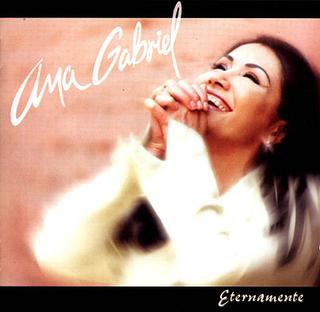
Eternamente is the 16th studio album by Mexican pop singer, Ana Gabriel. It was released in 2000. This material shows a nostalgic Ana Gabriel where she pays tribute to the Bolero's fathers Los Panchos and Los Diamantes. It was recorded at Sony Studios, Mexico.

Huelo a soledad is the 17th studio album by Mexican pop singer, Ana Gabriel. It was released in 2001. This album was nominated for Female Pop album of the Year in the Billboard Latin Music Awards, but lost to Jaci Velasquez's Mi Corazón.

Dulce y salado is the 18th studio album by Mexican pop singer, Ana Gabriel. It was released in 2003. This album won for Regional Mexican Album Of The Year, Female Group or Female Solo Artist in the Billboard Latin Music Awards.

Tradicional is the 19th studio album by Mexican pop singer, Ana Gabriel. It was released in 2004. This album goes from the regional styles of Mexican music to ska. It was nominated in the category of Best Ranchero Album in the Latin Grammy Awards of 2005, but lost to Luis Miguel's México en la Piel.
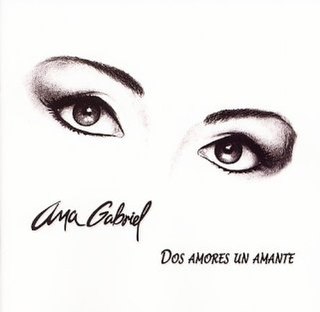
Dos amores un amante is the 20th studio album by the Mexican pop singer, Ana Gabriel. It was released in 2005. It was produced by herself. It was nominated in the category of Female Latin Pop Album Of The Year in the Latin Billboard Music Awards of 2007, but lost to Paulina Rubio's Ananda.

La Reina Canta a México is a compilation album by the Mexican pop singer, Ana Gabriel. It was released in 2006. It won in the category of Regional Mexican Album of the Year, Female Group or Female Solo Artist in the Latin Billboard Music Awards of 2007.
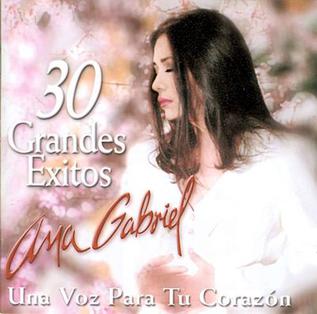
Una Voz Para tu Corazón – 30 Grandes Éxitos is a compilation album by the Mexican pop singer, Ana Gabriel.
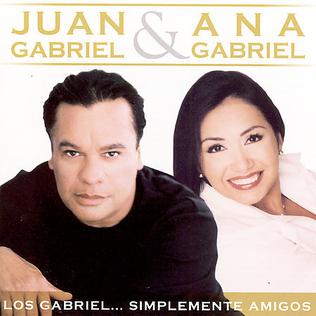
Los Gabriel… Simplemente Amigos is a compilation album by the Mexican singers Ana Gabriel and Juan Gabriel. It was released in 2007 under the label of Sony BMG Latin.

Los Gabriel: Para ti is a compilation album by Mexican singers Ana Gabriel and Juan Gabriel. After the success of the romantic album Los Gabriel… Simplemente Amigos, edited in 2007, and Los Gabriel: Cantan a México regional genre cd, edited in 2008, Sony BMG Latin presents a package of this two collections.
"Simplemente Amigos" is a ballad written and performed by Mexican singer-songwriter Ana Gabriel. It was produced by Mariano Pérez Bautista and was released on June 22, 1988 as the second single from her studio album Tierra de Nadie (1988). The song became Gabriel's second number-one single in the Billboard Hot Latin Tracks chart after "Ay Amor" in 1987. The success of the song led its parent album to its peak at number one in the Billboard Latin Pop Albums and approximate sales of six million units in Latin America.
"¡Ay, amor!" is a ballad written and performed by Mexican singer-songwriter Ana Gabriel and produced by Mariano Pérez Bautista. It was released as the first single from her third studio album Pecado Original (1987). This song became the second to spend 14 consecutive weeks at number one in the Billboard Hot Latin Tracks chart, after fellow Mexican singer Daniela Romo with "De Mí Enamórate", being surpassed in the same year by Yuri when her single "Qué Te Pasa" achieved sixteen weeks at the top of the chart.
"Y Ahora Te Vas" is a song written and produced by Mexican singer-songwriter Marco Antonio Solís, and performed by him as the lead singer of Los Bukis. It was released as the first single from their Grammy nominated album Si Me Recuerdas (1988). This song became their first number-one single in the Billboard Hot Latin Tracks chart.
"Quién Como Tú" is a song written and performed by Mexican singer-songwriter Ana Gabriel. It was produced by Óscar Gómez for Gabriel's fifth studio album of the same title (1989). Released as the second single from the album, the song became the third number-one single for the singer in the Billboard Top Latin Songs chart in May of the same year. Live performances of the song can be found on the albums En Vivo and ...En la Plaza de Toros México.
"Hasta Que Te Conocí" is a song written, produced, and performed by Mexican singer-songwriter Juan Gabriel. It was released in 1986 as the third single from his studio album Pensamientos. In the song, the protagonist learns the meaning of suffering after meeting a lover who mistreats him. It peaked at number two on the Billboard Hot Latin Song chart. A live version of the song was included on his album En el Palacio de Bellas Artes (1990) which peaked at number ten on the Hot Latin Songs chart.
